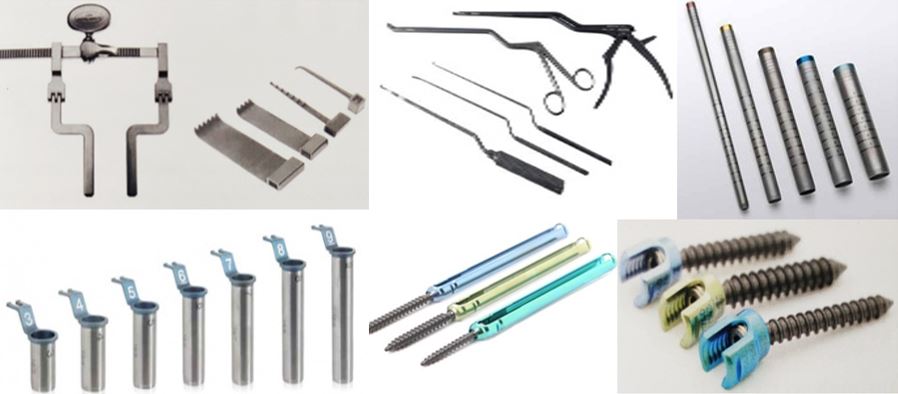Micro-Endoscopic Tubular Minimal Invasive Spine Surgery - Overview
Abstract
Damage to paraspinal muscles as by caused by conventional open posterior lumbar spinal surgery can lead to inferior clinical and functional results. Minimally invasive approach to lumbar spine by microscopic, endoscopic or micro-endoscopic techniques using specialised instruments via neuro-vascular planes using muscle splitting approach to accesses the pathological site can reduce or minimise these complications. MIS techniques have demonstrated less blood loss, less postoperative pain, decreased need of analgesics post operatively, faster rehabilitation, shorter hospital stays and lower infection rates as compared to open techniques. while achieving equally efficacious results.
A thorough knowledge of anatomy of posterior spinal structures and understanding of the instruments used in minimal invasive spine surgery is of paramount importance. This article focusses on the anatomy, history, basics, instrumentation and indications used in minimally invasive lumbar spine surgeries.
Downloads
References
2. Bogduk N. Functional anatomy of the spine. Handb Clin Neurol. 2016;136:675-88.
3. Kim KT, Lee SH, Suk KS, Bae SC. The Quantitative Analysis of Tissue Injury Markers After Mini-Open Lumbar Fusion. Spine (Phila Pa 1976). 2006;15;31(6):712-6.
4. Lee JC, Jang HD, Shin BJ. Learning Curve and Clinical Outcomes of Minimally Invasive Transforaminal Lumbar Interbody Fusion: Our Experience in 86 Consecutive Cases. Spine (Phila Pa 1976). 2012;15;37(18):1548-57.
5. Stevens KJ, Spenciner DB, Griffiths KL, et al. Comparison of Minimally Invasive and Conventional Open Posterolateral Lumbar Fusion Using Magnetic Resonance Imaging and Retraction Pressure Studies. J Spinal Disord Tech. 2006;19(2):77-86.
6. Pool J. Direct visualization of dorsal nerve roots of the cauda equina by means of myeloscope. Archives of Neurology and Psychiatry. 1938;39:1308-12.
7. MM FKTS. Microendoscopic discectomy techniques in Neurosurgery. 1997;3:301-7.
8. Rosen DS, Ferguson SD, Ogden AT, Huo D, Fessler RG. Obesity and self-reported outcome after minimally invasive lumbar spinal fusion surgery. Neurosurgery. 2008;63(5):956-60.
9. Dhall SS, Wang MY, Mummaneni PV. Clinical and radiographic comparison of mini-open transforaminal lumbar interbody fusion with open transforaminal lumbar interbody fusion in 42 patients with long-term follow-up. J Neurosurg Spine. 2008;9(6):560-5.
10. Park Y, Ha JW. Comparison of one-level posterior lumbar interbody fusion performed with a minimally invasive approach or a traditional open approach. Spine (Phila Pa 1976). 2007;1;32(5):537-43.
11. Peng CW, Yue WM, Poh SY, Yeo W, Tan SB. Clinical and radiological outcomes of minimally invasive versus open transforaminal lumbar interbody fusion. Spine (Phila Pa 1976). 2009;1;34(13):1385-9.
12. Vazan M, Gempt J, Meyer B, Buchmann N, Ryang YM. Minimally invasive transforaminal lumbar interbody fusion versus open transforaminal lumbar interbody fusion: a technical description and review of the literature. Acta Neurochir (Wien). 2017;159(6):1137-1146.
13. Kim CW, Lee YP, Taylor W, Oygar A, Kim WK. Use of navigation-assisted fluoroscopy to decrease radiation exposure during minimally invasive spine surgery. Spine J. 2008;8(4):584-90.

The entire contents of the Orthopaedic Journal of Madhya Pradesh Chapter are protected under Indian and International copyrights. Orthopaedic Journal of Madhya Pradesh Chapter allow authors to retain the copyrights of their papers without restrictions, Authors grant the publisher the right of exclusive publication. The Journal then grants to all users a free, irrevocable, worldwide, perpetual right of access to, and a license to copy, use, distribute, perform and display the work publicly and to make and distribute derivative works in any digital medium for any reasonable non-commercial purpose, subject to proper attribution of authorship. The journal also grants the right to make numbers of printed copies for their personal non-commercial use under Creative Commons Attribution-Non-commercial share alike 4.0 International Public License.

 OAI - Open Archives Initiative
OAI - Open Archives Initiative












